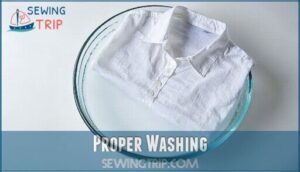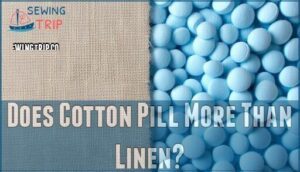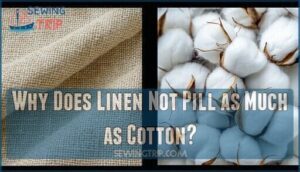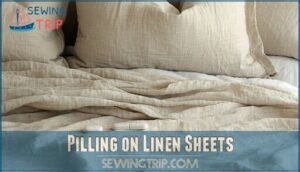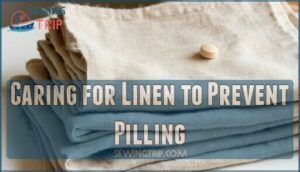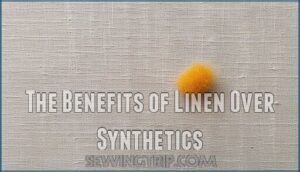This site is supported by our readers. We may earn a commission, at no cost to you, if you purchase through links.
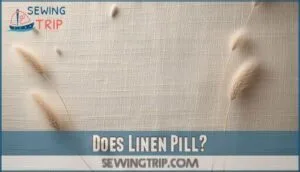 Does linen pill? Yes, but barely.
Does linen pill? Yes, but barely.
Linen’s long, strong flax fibers resist the friction that creates those pesky fabric balls on your clothes and sheets.
You’ll see minimal pilling compared to cotton or synthetics because linen’s loose weave lets fibers move freely without tangling.
Any initial pilling you notice on new linen typically disappears as the fabric softens with wear.
The secret lies in linen’s natural structure – those lengthy fibers simply don’t break off and clump together like shorter cotton fibers do.
With proper care, your linen actually gets better with age, developing that coveted lived-in softness while staying pill-free.
Table Of Contents
- Key Takeaways
- What Causes Fabric Pilling?
- Does Linen Pill?
- How to Prevent Linen Pilling
- Does Cotton Pill More Than Linen?
- Do Other Fabrics Pill Less Than Linen?
- Why Does Linen Not Pill as Much as Cotton?
- Pilling on Linen Sheets
- Removing Pills From Linen
- Caring for Linen to Prevent Pilling
- The Benefits of Linen Over Synthetics
- Frequently Asked Questions (FAQs)
- Conclusion
Key Takeaways
- You’ll find linen pills far less than cotton or synthetics because its long, strong flax fibers resist breaking and tangling into those annoying fabric balls that plague other materials.
- When linen does pill, it’s actually a good thing – the loose fibers naturally shed away instead of clumping together, and your fabric gets softer and better-looking with age rather than deteriorating.
- You can prevent most linen pilling by washing it separately on gentle cycles with cold water and mild detergent, then air drying instead of using high heat that weakens the natural fibers.
- If you do notice pills on your linen, you can easily remove them with a fabric shaver, razor blade, or pumice stone, but they’ll likely disappear on their own as the fabric continues to soften with wear.
What Causes Fabric Pilling?
Fabric pilling happens when short fibers break free from loose weaves and tangle together into small balls on your fabric’s surface.
Those pesky little fabric balls aren’t just annoying—they’re your textile’s cry for help when fibers can’t hold on anymore.
You’ll notice these fuzzy clusters form most often in high-friction areas where abrasion from washing, wearing, and rubbing weakens the threads.
Fiber Length
Think of fiber length as the foundation of pilling resistance. Linen’s naturally longer fibers create stronger bonds that resist breaking under stress.
When you choose linen fabric, you’re getting robust fiber strength that won’t easily snap into those annoying little balls. Short fibers in cotton and synthetic blends break more readily, creating loose ends that tangle together.
The blend lengths matter too – mixing long and short fibers increases pilling risk. Linen fiber naturally resists this process, making linen pilling far less common than other materials.
Loose Weave
Loose weave construction directly impacts your linen’s pilling susceptibility.
When yarns aren’t tightly bound together, fabric stability decreases and yarn slippage occurs more easily.
This creates movement between fibers during washing and wearing.
Higher weave density in quality linen reduces this problem, though even premium linen fabric pills eventually.
Tighter linen weave construction minimizes why linen pills compared to loosely woven alternatives, highlighting the importance of weave density and fabric stability.
Abrasion
Fabric rubbing creates the perfect storm for pilling. When linen fabric pills, it’s usually because friction impact has weakened the fibers through constant surface damage.
Common sources of fabric abrasion include:
- Washing machine agitation and harsh detergents
- Body movement against clothing during daily wear
- Contact with rough surfaces like backpack straps
Understanding why linen pills helps you choose better pilling prevention methods to mitigate the effects of fabric abrasion.
Does Linen Pill?
Linen pills less than most fabrics because its long, natural fibers shed loose threads instead of clumping together into fuzzy balls.
You’ll find that quality linen actually gets better with age as the loose fibers work free and fall away naturally, making it a great choice over time due to its ability to improve with age.
Linen Fibers Shed
Here’s the difference between shedding vs. pilling: linen fiber naturally sheds loose threads instead of forming pills.
This fiber degradation works in your favor. When you rub linen fabric, individual fibers break away cleanly rather than tangling into fuzzy balls.
The weave impact matters too – linen’s loose structure allows damaged fibers to escape easily. Friction effects cause shedding, not clumping.
Quality linen care preserves this natural process. Unlike cotton’s stubborn pilling behavior, linen shedding keeps your fabric smooth. This makes linen pilling rare compared to synthetic materials that trap broken fibers, and it highlights the benefit of linen shedding and the importance of quality linen care.
Improves With Age
Your linen gets better with every wash cycle.
Your linen becomes more beautiful with age – soft, refined, and gracefully weathered like fine wine.
Unlike synthetic fabrics that deteriorate, linen develops character and softens over time, creating heirloom quality textiles.
This natural aging process reduces linen pilling while enhancing durability factors.
The fibers naturally shed loose ends, preventing pill formation that plagues other materials.
You’re making a sustainable choice that improves rather than degrades, proving linen’s superior longevity and exceptional linen quality through proper linen care.
How to Prevent Linen Pilling
You can keep your linen looking smooth and new by following simple care steps that protect the fabric’s natural fibers.
Proper washing techniques and air drying methods will help prevent pilling and extend your linen’s lifespan.
Proper Washing
The key to preventing linen pilling starts with your washing routine.
Your linen deserves gentle treatment to maintain its natural beauty and longevity. Follow these essential linen washing tips to keep your fabrics looking their best:
- Washing separately: Keep linen away from rougher fabrics like denim or towels that can cause friction
- Water temperature: Use cold water exclusively – heat breaks down linen’s delicate fibers
- Gentle detergents: Choose mild, bleach-free formulas that won’t strip or weaken the natural fibers
- Cycle selection: Select delicate or hand wash settings to minimize agitation and stress
- Wash frequency: Clean only when necessary – overwashing accelerates fiber breakdown
These linen maintenance practices protect the long bast fibers that make linen naturally resistant to pilling.
With proper cycle selection and careful attention to laundry tips, your linen will soften beautifully over time while maintaining its structure and preventing unsightly pills.
Air Drying
After proper washing, skip the dryer and embrace nature’s gentle touch. Air drying prevents linen pilling by reducing fiber stress and maintaining fabric softness. Sunlight exposure naturally sanitizes while gentle airflow allows fibers to relax without harsh tumbling.
You can find a suitable drying solution for your needs.
| Drying Method | Environmental Impact | Fabric Benefits |
|---|---|---|
| Air Drying | Zero energy consumption | Preserves fiber integrity |
| Low Heat Dryer | Moderate energy use | Some fiber stress |
| High Heat Dryer | High energy consumption | Damages delicate fibers |
| Indoor Hanging | Minimal environmental cost | Slower drying time |
This approach extends linen fabric lifespan while supporting linen maintenance goals.
Does Cotton Pill More Than Linen?
Cotton definitely takes the hit in terms of pilling compared to linen.
This Fiber Comparison reveals why: cotton’s shorter fibers break free easily, creating those annoying fuzz balls you’ve probably noticed on your favorite t-shirts.
Linen fiber, being naturally longer and stronger, stays put much better.
Here’s where Weave Matters – cotton’s looser construction lets those short fibers escape, while linen’s tighter weave keeps everything locked in place.
The Pilling Resistance of linen vs cotton isn’t even close.
Cotton Quality does make a difference though – high-end Pima cotton with longer fibers fights back better than regular cotton.
Linen Durability shines through because it’s actually 30% stronger than cotton.
While both fabrics can develop pills with heavy use, linen pilling happens far less frequently.
Smart fabric pilling prevention starts with choosing linen over cotton when you want long-lasting, pill-resistant textiles.
Do Other Fabrics Pill Less Than Linen?
Several fabrics outperform linen in terms of pilling resistance. Silk vs linen shows a clear winner – silk’s long, continuous fibers create a sleek surface that resists tangling and pill formation.
Denim pilling resistance comes from its tight weave that prevents fiber loosening, making it one of the most durable options available. Premium wool and cashmere also beat linen’s performance, with their natural fibers shedding less noticeably than linen’s shorter strands.
Microsuede durability stands out too, with its synthetic construction nearly eliminating pilling issues entirely. While rayon pilling tendency varies, TENCEL alternative offers smooth texture with minimal pill formation.
Fabric blends containing these superior materials often provide better fabric pilling resistance than pure linen, giving you longer-lasting textiles.
Why Does Linen Not Pill as Much as Cotton?
Linen fiber strength comes from its naturally long strands that resist breaking under stress.
Cotton fiber weakness shows up quickly because its shorter fibers snap and tangle into pills.
The weave density comparison reveals linen’s looser structure actually helps – damaged fibers shed away instead of clumping together like cotton’s tighter weave traps them.
Natural oil content in linen material creates friction resistance differences that cotton can’t match.
This built-in protection enhances linen durability while maintaining that distinctive linen texture you love.
Cotton’s cellulose structure lacks these protective oils, making it more vulnerable to wear.
Smart pilling prevention starts with choosing naturally resilient fabrics like linen for superior fabric durability.
Pilling on Linen Sheets
When choosing linen sheets, you’ll discover that linen sheet quality directly affects pilling resistance.
High-grade linen fabric naturally sheds loose fibers instead of forming unsightly pills that plague other materials.
Several factors determine your sheets’ longevity:
- Weave impacts pilling – Tighter weaves resist fiber movement and pill formation
- Thread count matters – Higher counts create smoother, more durable surfaces
- Linen blend pilling varies based on synthetic fiber percentages mixed in
- Pilling appearance differences show less on linen due to natural fiber shedding
Pure linen sheets develop character through use, becoming softer without compromising linen durability.
While preventing linen pilling starts with quality selection, proper care maintains your investment for years.
Removing Pills From Linen
Frustration dissolves when you tackle linen pilling with the right approach. Start with a fabric shaver set to low speed—it’s your best friend for pill removal without damaging delicate fibers.
For stubborn areas, try sanding blocks or pumice stones with gentle circular motions. You can find a linen fabric shaver online.
| Tool | Best For |
|---|---|
| Fabric shaver | Large pilled areas |
| Lint rollers | Light surface fuzz |
| Sanding blocks | Stubborn pills |
DIY methods work too. Use a plain razor blade at 45-degree angles, shaving in short strokes. Always pull the fabric taut over a flat surface. Lint rollers handle surface pills effectively on smaller sections.
These antipilling tools restore your linen’s smooth texture. Remember—gentle pressure prevents fabric damage while achieving professional pilling removal results.
Caring for Linen to Prevent Pilling
You can keep your linen looking smooth and pill-free by following simple washing and drying steps. Proper care techniques protect the long fibers that make linen naturally resistant to pilling.
Washing
Your washing machine can be linen’s best friend or worst enemy. The key lies in treating linen clothing with the respect this natural fabric deserves.
Proper washing techniques prevent fabric pilling while preserving linen’s unique texture and durability.
- Use gentle detergents without harsh chemicals or brighteners that weaken fibers
- Set water temperature to cool or lukewarm to prevent fiber damage and shrinkage
- Select the gentle cycle with minimal agitation to reduce friction between threads
Wash frequency matters too. Don’t overwash linen fabric unless truly necessary. Consider using a specialized linen detergent for superior care.
Skip fabric softeners, which coat fibers and attract dirt. Always wash linen separately from rough materials like denim to ensure the longevity of your linen clothing.
Drying
After washing comes the critical drying phase.
Air drying your linen clothing prevents fabric pilling by avoiding harsh tumble drying cycles.
Skip high drying temperatures that weaken fibers.
Line drying protects linen fabric from damage while maintaining softness.
Avoid dryer sheets – they create residue buildup.
When ironing linen, use medium heat to smooth wrinkles without compromising fiber integrity, and this helps in preventing fabric pilling and maintaining the linen’s natural softness, which is the goal of air drying.
The Benefits of Linen Over Synthetics
You’ll find that linen’s natural fibers resist pilling far better than synthetic materials like polyester or acrylic.
Unlike synthetics that trap pills on their smooth surfaces, linen’s long fibers naturally shed loose threads, keeping your fabric looking fresh as it ages, because linen’s natural fibers have a unique ability to naturally shed loose threads.
Natural Fibers
Unlike synthetic alternatives, natural fibers offer superior comfort and longevity.
Linen’s natural durability stems from its robust fiber strength and tight weave density, making it resistant to fabric pilling.
When you choose linen fabric over synthetic fiber blends, you’re investing in sustainable sourcing and better fabric care outcomes.
Natural fibers like linen become softer with each wash, while synthetics deteriorate quickly.
The inherent properties of natural fibers create a breathable, comfortable experience that improves over time, making linen an excellent choice for long-term use.
Ages Better
While synthetics deteriorate with each wash, linen’s weave integrity actually improves over time.
Your linen develops natural softness and timeless appeal that cotton can’t match.
The fabric’s fiber strength increases with age, creating heirloom-quality pieces with exceptional linen longevity.
Instead of pilling like other materials, linen’s fabric durability enhances its fabric quality through years of use, contributing to its timeless appeal.
Frequently Asked Questions (FAQs)
Do linen fabrics pill?
Linen does pill, but you’re in luck—it’s less prone than cotton or synthetics.
The long, natural fibers resist tangling, and when pills do form, they typically shed naturally over time with regular wear.
Can linen pill?
Yes, linen can pill, but it’s less prone than synthetic fabrics.
You’ll notice it mainly with lower-quality linen or rough handling.
The long natural fibers resist pilling better than cotton blends or polyester materials, and this makes linen a more durable option.
Why does linen pill?
Friction during washing and wear causes linen’s shorter fibers to break free and tangle together.
When you mix low-quality linen with synthetic blends, you’ll see more pilling from the weaker fibers bundling up.
Do linen sheets pill?
Like a well-worn path that smooths with time, your linen sheets won’t pill much.
They’ve got long, sturdy fibers that resist tangling.
You’ll see minimal pilling compared to cotton or synthetic blends, especially with proper care.
What causes a pill on a bed linen?
Short fibers break free during washing and wearing, then tangle together on your bed linen’s surface.
Friction from tossing, turning, and laundering causes these loose threads to bundle into those annoying fuzzy balls you notice.
Do all fabrics pill?
Not every fabric pills equally.
Natural fibers like silk and high-quality cotton resist pilling better than synthetics.
You’ll find polyester and acrylic, and cotton blends pill most, while denim and microsuede stay virtually pill-free.
How Can I Remove Pilling From My Linen Clothes?
You can remove pilling from linen clothes using a fabric shaver, razor blade, or pumice stone.
Gently glide the tool across affected areas, then wash inside-out on gentle cycle to prevent future pilling.
What’s the Difference Between Linen Fabric Pilling and Cotton Pilling?
Ironically, both fabrics pill, but linen’s long fibers create less noticeable pills that naturally shed off, while cotton’s shorter fibers form stubborn pills that cling tightly to the fabric surface.
Does Linen Bedding Pill as Much as Cotton Bedding?
Linen bedding pills substantially less than cotton bedding.
You’ll notice fewer fabric balls because linen’s long fibers resist breaking and tangling.
Cotton’s shorter fibers create more pills, especially in cotton-polyester blends.
Is Pilling on Linen Normal and What Causes It?
Like your grandmother’s well-worn quilt, linen’s natural fibers can develop small pills over time.
You’ll notice minimal pilling compared to synthetic fabrics since linen’s long fibers resist tangling, making any pills fall away naturally, with minimal pilling and natural fibers being key characteristics.
Conclusion
Like a well-aged wine, linen only improves with time.
While the question "does linen pill?" might concern new buyers, rest assured that linen’s natural resistance to pilling makes it superior to cotton and synthetics.
You’ll enjoy minimal fabric balls thanks to those long flax fibers and loose weave structure, and proper washing techniques will contribute to this.
Follow these techniques, air dry when possible, and watch your linen develop that coveted softness while staying remarkably pill-free for years to come.

